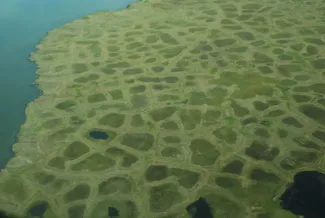Potential carbon emissions dominated by carbon dioxide from thawed permafrost soils
An international team led by Northern Arizona University scientists and involving a number of NGEE Arctic researchers, used two meta-analyses to investigate the greenhouse gas release from soils sampled from across the permafrost zone and warmed in laboratory incubations. The first analysis focused on the amount of carbon released in response to warming, while the second analysis focused on the difference in the relative amount of carbon released as carbon dioxide or methane under aerobic or anaerobic soil conditions. Potential warming of 10°C increased total carbon release by a factor of two, and even when taking into account the stronger warming potential of methane, total carbon release was greatest under aerobic soil conditions. The implications of these results are that drier soils may provide a larger, positive feedback to global warming than wetter soils. The NGEE Arctic team (Iversen, Graham, Norby, Sloan, and Roy Chowdhury) contributed multiple data sets to this international effort. Phase 2 of the NGEE Arctic project is focused on addressing some of the key questions raised by this research. For example, where, when, and why will the Arctic become wetter or drier, and what are the implications of climate forcing? How should these processes be represented by mechanistic models of the Arctic?
Rapid warming in the Arctic is leading to the thawing of carbon-rich soils that have been permanently frozen for millennia. The release of greenhouse gases from thawed permafrost could increase the rate of global warming, but this depends on the amount of carbon released into the atmosphere, and whether carbon is released as carbon dioxide or the more potent greenhouse gas methane.
Across the Arctic, the total amount of carbon released from thawing soils, and whether the carbon was released as carbon dioxide or methane, was related to whether soils were drier and aerobic or waterlogged and anaerobic. Total carbon release, even when taking into account the stronger warming potential of methane, was greatest under aerobic soil conditions, indicating that drier soils may provide a larger, positive feedback to global warming than wetter soils.
Schädel, C, M Bader, E Schuur, et al. 2016. Potential carbon emissions dominated by carbon dioxide from thawed permafrost soils. Nature Climate Change 6:950–953. https://doi.org/10.1038/nclimate3054
Financial support was provided by the National Science Foundation Vulnerability of Permafrost Carbon Research Coordination Network Grant no. 955713 with continued support from the National Science Foundation Research Synthesis, and Knowledge Transfer in a Changing Arctic: Science Support for the Study of Environmental Arctic Change Grant no. 1331083. Author contributions were also supported by grants to individuals: Department of Energy, Office of Biological and Environmental Research, Terrestrial Ecosystem Science (TES) Program (DE-SC0006982) to E.A.G.S.; UK Natural Environment Research Council funding to I.P.H. and C.E.-A. (NE/K000179/1); German Research Foundation (DFG, Excellence cluster CliSAP) to C.K.; Department of Ecosystem Biology, Grant agency of South Bohemian University, GAJU project no. 146/2013/P and GAJU project no. 146/2013/D to H.S.; National Science Foundation Office of Polar Programs (1312402) to S.M.N.; National Science Foundation Division of Environmental Biology (0423385) and National Science Foundation Division of Environmental Biology (1026843), both to the Marine Biological Laboratory, Woods Hole, Massachusetts; additionally, the Next-Generation Ecosystem Experiments in the Arctic (NGEE Arctic) project is supported by the Biological and Environmental Research programme in the US Department of Energy (DOE) Office of Science. Oak Ridge National Laboratory is managed by UT-Battelle, LLC, for the DOE under Contract no. DE-AC05-00OR22725. Support for C.B. came from European Union (FP-7-ENV-2011, project PAGE21, contract no. 282700), Academy of Finland (project CryoN, decision no. 132 045), Academy of Finland (project COUP, decision no. 291691; part of the European Union Joint Programming Initiative, JPI Climate), strategic funding of the University of Eastern Finland (project FiWER) and Maj and Tor Nessling Foundation and for P.J.M. from Nordic Center of Excellence (project DeFROST).
For more information, please contact:
Colleen Iversen
iversencm@ornl.gov

